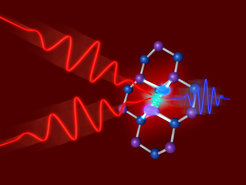Phonon-enhanced nonlinearities in layered materials
Parametric optical processes in solids reveal critical information about a crystal's properties like optical susceptibility and band-structure, profoundly influencing nonlinear frequency-conversion. Published in Nature Communications, the study titled "Phonon-Enhanced Nonlinearities in Hexagonal Boron Nitride" sheds light on the optical nonlinearities induced and amplified by strong phonon resonances within hexagonal boron nitride (hBN). This research comprising both nonlinear optics experiments and TDDFT calculations presents a new frontier in understanding crystal behaviors and their impact on nonlinear frequency-conversion processes.
The investigation focused on the interaction between optical phonon resonances within hBN, uncovering a series of transformative findings: Firstly, the group predicted and observed remarkable sub-picosecond duration signals due to four-wave mixing during resonant excitation, enabling time-resolved observation of crystal motion. Secondly, the authors observed >30-fold enhancements in third-harmonic generation under resonant optical pumping of the transverse optical phonon of hBN, showcasing the potential for significantly increased high-harmonic efficiencies. The theory calculations are in agreement with experiments. These discoveries hold immense potential for technological advancements in various fields relying on optical materials and nonlinear optics, promising new avenues for innovative applications in photonics, quantum computing, and more.

Jared Ginsberg, a fellow co-first author of the paper, sees this as an important milestone in nonlinear optics of 2D materials: “hBN is only the beginning when it comes to explorations of nonlinear phononics in the van der Waals type materials. I see these results as providing the evidence necessary to really motivate the continued exploration of harmonic effects beyond second order in 2D materials. I hope to see the field continue to expand into newer materials and longer wavelengths in the coming years.” Cecilia Chen, a graduate student at Columbia who also contributed to the experimental side of the study as a co-first author, looks forward to future developments in the field of coherent strong coupling between an optical pump and a material’s vibrational modes: “Our results support the concept that many fundamental properties of crystals stemming from their physical structure can be tuned or modulated optically,” she explains.
Jin Zhang, one of the corresponding authors and co-first authors of the study, views the findings as an exciting step forward: "The observed phonon-induced nonlinear enhancements represent a paradigm shift in our understanding of crystal behavior under resonant optical excitation. The experiments are in excellent agreement with our TDDFT simulation. This opens doors to harnessing these effects for novel applications in optical technologies."
This groundbreaking study not only advances the fundamental understanding of material properties but also paves the way for transformative applications in the realm of nonlinear optics and beyond.












